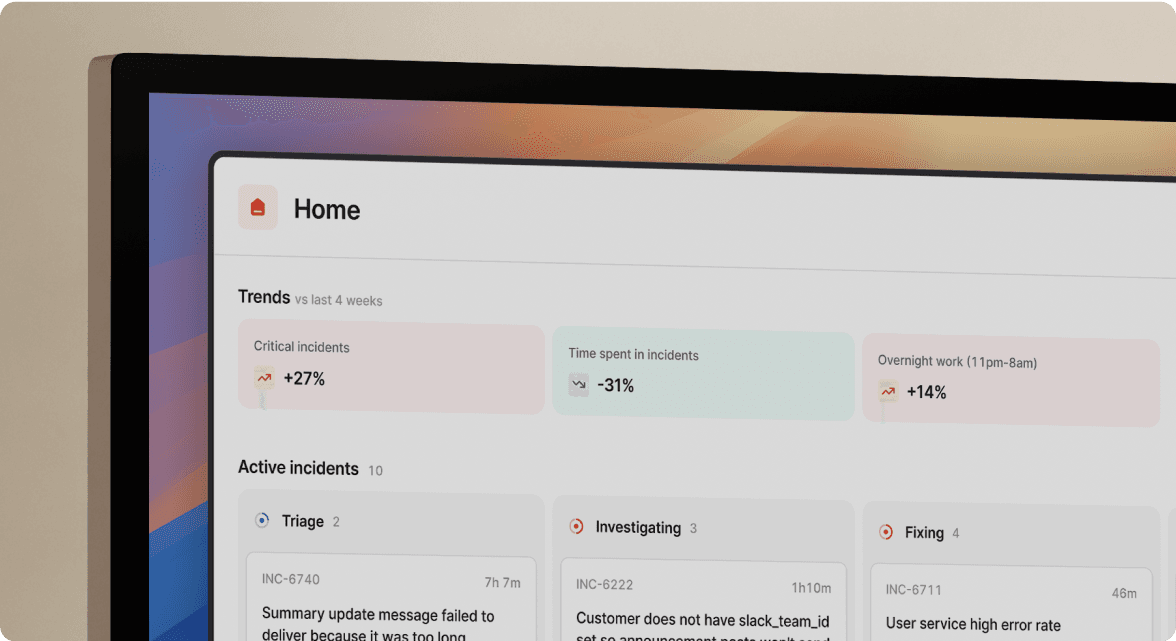A seven-step framework for running incident debriefs

Ever wrapped up an incident, thought 'Phew, glad that’s over,' only to feel your stomach drop when you see the dreaded "Incident Debrief" on your calendar? We've all been there. Incident debriefs don't need to feel like sitting through your least favorite school subject. They can (and should!) actually be engaging and useful.
At incident.io, we've found a simple, repeatable, and blameless framework. Let’s walk through it with practical insights from real incidents, so you can turn incidents into genuine improvements.
Step 1: Ditch the blame game
Set the tone. Your debrief isn't about finding a scapegoat; it's about understanding what happened so you can improve. Remind everyone upfront that you're all here to learn, not point fingers. Creating a safe space encourages people to openly share their perspectives, even if that means owning up to mistakes.
Step 2: Map it out
Your goal here is to reconstruct a clear, factual timeline. Stick strictly to facts: what happened, when, and how it unfolded. Your timeline is the backbone of your discussion, and clarity beats complexity every time.
A tip from real debriefs: encourage active participation during the timeline review. Get folks involved by asking open-ended questions like, "What led you to restart that service?" or "Why did that alert trigger at this particular moment?" Real-world details will flow naturally, and you'll uncover insights you might have missed otherwise.
Step 3: Focus on real-world impact
Incidents aren't just about broken servers; they're about broken experiences and impacted people. Clearly highlight how users were affected. It doesn't matter if the outage was 5 minutes or 5 hours; it's worth understanding if it impacted someone’s day. Keep your focus user-first: "What felt broken to them?" This grounds the conversation in reality and urgency.
Step 4: Evaluate your response
Bring transparency to the table. Openly discuss how quickly you identified the problem, which tools helped (or didn’t), and how effectively your team communicated internally and externally. Experience has shown that unclear or confusing visualizations can delay diagnosing incidents. For example, did your monitoring and alerting tools provide clear, actionable information your team could easily interpret during the incident?
Step 5: Extract actionable lessons
Incidents are packed with lessons. At incident.io, we put each insight through the "so what?" test. For example, "Disk space filled up." Okay, so what? Next time we add monitoring. "New engineers struggled to follow rollback steps." So what? Improve documentation or training. Every lesson should clearly lead to improvements you can implement.
Also discuss the surprises the team feels, like really bad alerts that almost never fire, but signify serious issues. Ensuring your team understands their significance and urgency can dramatically improve response times, and socializing these learnings can help develop greater organizational resilience over time.
Step 6: Commit to improvements
Assign clear owners and due dates for follow-up actions, like enhancing alerts, adding redundancy, or improving documentation. Be especially careful with concurrency and backfill operations; set practical limits, regularly review defaults, and educate your team on the implications of these settings. Don't overload yourself with impossible promises. Pick a few solid, achievable changes rather than dozens of vague "we should fix this someday" actions. Keep it lean, realistic, and impactful.
Pro tip from our incident management guide: Give action items some breathing room. Don't jump to immediate action under pressure. Sleep on it overnight, then revisit to ensure you're making smart, strategic choices, not emotional reactions.
We wrote more about action items in incident debriefs here!
Step 7: Finish strong
End your meeting positively. Reiterate that incidents aren’t just bad days but opportunities to build a stronger, smarter team. Celebrate what went well, whether it was a quick response, good teamwork, or how everyone rallied together. Positivity sticks.
After the debrief: document and follow-up
A debrief isn’t done until it's documented and shared. Turn insights into an accessible incident report, then share it broadly. This spreads knowledge, builds transparency, and makes future incidents easier to handle. Set reminders to check in on action items. Nothing kills momentum faster than good intentions without follow-through.
Bonus tip: iterate and improve your debriefs
Your debrief process will evolve. Regularly ask your team what's working and what's not, then refine your approach. You're building a ritual, not a rulebook.
That's it: a structured, practical framework your team might actually enjoy. Ready to turn your next incident into your team's favorite learning opportunity? Let me know what works (or doesn't) for you!

I'm one of the co-founders, and the Chief Product Officer here at incident.io.
See related articles
So good, you’ll break things on purpose
Ready for modern incident management? Book a call with one of our experts today.

We’d love to talk to you about
- All-in-one incident management
- Our unmatched speed of deployment
- Why we’re loved by users and easily adopted
- How we work for the whole organization



